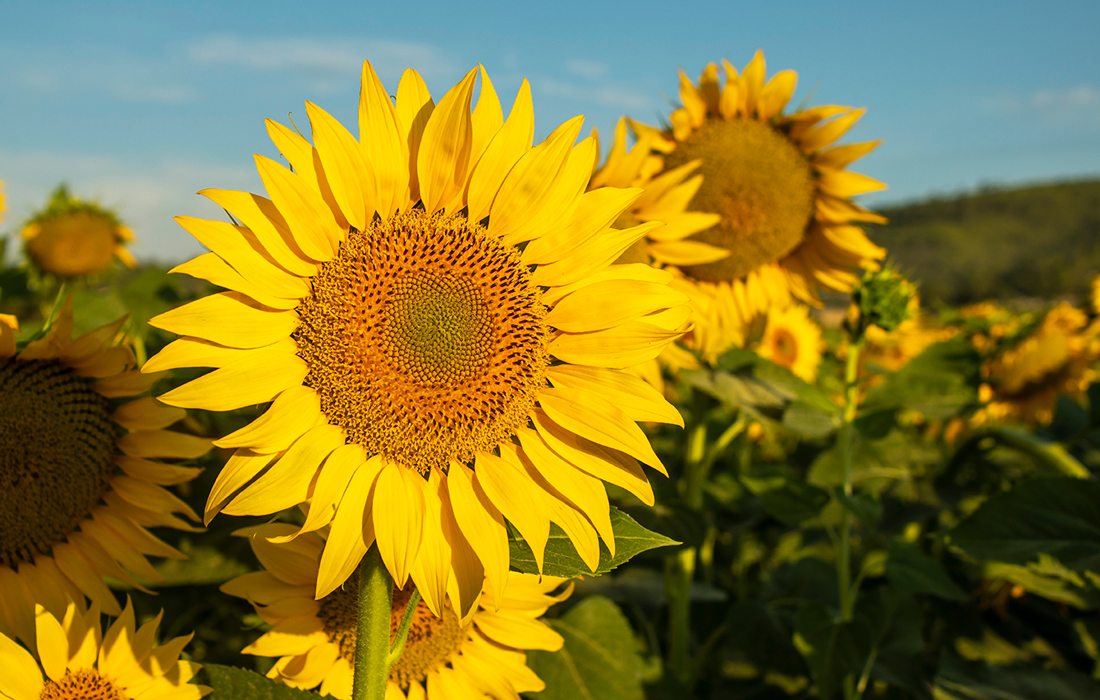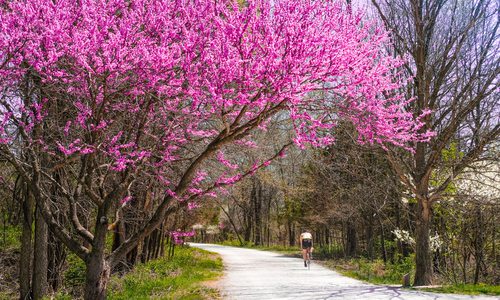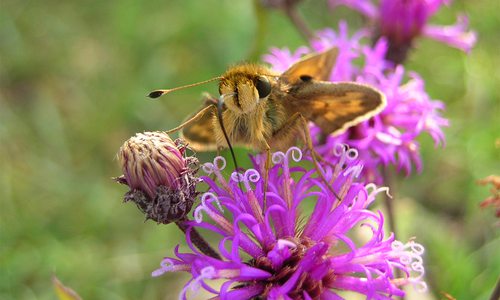Gardening
What to Plant Right Now
Take advantage of southwest Missouri’s long planting seasons, and choose colorful plants that will spruce up your beds all year long.
by Heather Kohler, Lucy Caile, Katie McWilliams, Katie Pollock Estes, Michelle Lewis
Jun 2024

When to Grow
What to Plant in the Summer
Tips for Growing Sunflowers
Plant your sunflower seeds in early June to enjoy a perfect crop of grown-at-home blooms in late August and September. August and September are the perfect time to enjoy sunflower blooms, and lucky for us, sunflowers can be easily sewn right into the ground. Early June is the time to make some room in your garden or outdoor space, because nothing says summertime like these happy flowers. “I love sunflowers because they are easy to grow, dramatic, and they add so much character to a garden,” says homesteader Amy Taylor. You can plant your seeds in garden beds, or plant them in containers. “I always plant more seeds than I actually need, that way if critters get a few or if some don’t germinate, you still have plenty of blooms,” says Taylor.
If you want to enjoy sunflowers that have fall color in them, try varieties like chocolate cherry, or red sun sunflower seeds from Baker Creek (92278 Baker Creek Road, Mansfield). If you’re looking for towering sunflowers, the Mongolian giant can grow up to 14 feet tall. “I like to plant them in groupings. They will be so dramatic and they will all lean on each other for support as they grow tall,” says Taylor. You can also plant them along a wall or fence for built-in support. Just make sure you plant your seeds somewhere that gets plenty of sun, because sunflowers need six to eight hours of direct sunlight per day.
Sunflowers are great as cut flowers. Bringing a hand-picked bouquet from your garden into your home can be quite magical, and since these flowers are so easy to grow, anyone can enjoy growing them, even if you don’t think you have a green thumb. Leaving some blooms out in your garden will attract wildlife as well. “At the end of the season when the flowers are dried up, leave them standing tall. You’ll have beautiful songbirds and finches visiting you every day enjoying the seeds,” says Taylor. “This is one of my favorite things about the end of the season.”
If a vegetable garden is more your speed, summer is the perfect
time to plant for some attractive blooms on those veggie plants. Okra
plants make beautiful lotus-type flowers, while runner beans produce
lovely itty bitty flowers. The meaty blooms that grow on zucchini plants
look nice but are edible to (try them battered and fried.)
Here are some more ideas to help you decide what to plant in July and August to have a delicious fall harvest.
Beets
When to plant: the first week of August
Days until harvest: 55 to 65
How to use them: Roasted
beets are flavorful and so simple to prepare. Once you’ve made them,
you can use them a variety of ways, like as a salad topper or a side
dish. Our favorite, though, is serving them chilled with goat cheese and
herbs. Raw beets make great juice blends, too (if juicing is your
thing). Although raw beets store well, you can make them last even
longer if you try pickling. It’s easier than you might think, and it is a
great way to preserve a bumper crop.
Broccoli
When to plant: late July to early August
Days until harvest: 70 to 80
How to use it: Pretty
much everyone knows how to cook this calcium-filled veggie. But there
are some perhaps less-obvious applications than the steamed, stir-fried
or roasted options you’re used to. Mince them and mix them with an egg,
breadcrumbs, cheese and seasoning, then form them into “tots” that you
can bake in the oven for healthy finger food.
Brussel Sprouts
When to plant: late July to early August
Days until harvest: 60 to 90
How to use them:
Quick fry them in a super-hot pan with lemon juice and garlic, and you
can’t go wrong. The smell alone is intoxicating. But Brussels sprouts
offer a lot of freedom to experiment. They are delicious raw, shaved
into a salad or slaw. They can be tossed whole onto a barbecue grill and
cooked alongside your protein. And perhaps the easiest application:
Roasting them in the oven. Perfection.
Carrots
When to plant: Late August
Days from planting to harvest: 60 to 80
How to use them:
Because they’re the ultimate snack veggie, you could just munch on your
carrot harvest. Or you can make a tasty slaw with some warm spices. Try
adding pumpkin seeds and curry powder to mix it up. They taste great
together.
Lettuce and Salad Greens
When to plant: early to mid-August
Days until harvest: 35 to 50
How to use them: There
are so many varieties of lettuce that you can plant that will thrive in
southwest Missouri and create a plentiful fall harvest. Experiment with
different leafy veggies to see what you like best in your salads: spicy
arugula, tender butterhead lettuce and crunchy loose leaf lettuce. Toss
them with some fresh herbs and your favorite toppings for something way
more delicious than the bagged salad you get at the store.
Radishes
When to plant: anytime in August
Days until harvest: 25 to 35
How to use them: Pickle
these pups! A quick and easy pickling recipe for classic red radishes
calls for vinegar, salt, sugar, red pepper flakes, cilantro and fresh
jalapeño. The result is something spicy and tart that looks as good as
it tastes on top of homemade tacos.
Spinach
When to plant: early to mid-August
Days until harvest: 40 to 50
How to use it:
There are the obvious applications (like salads), but spinach is also
fun to use for creative entrees. Purchase some pre-made phyllo dough,
and make a batch of spanakopita. The savory Greek pastry is packed with
this green leafy vegetable, along with pungent feta cheese. It’s a
great, shareable way to show off your harvest.
Turnips
When to plant: late July to mid-August
Days until harvest: 50 to 60
How to use them:
Gather up a variety of root vegetables (turnips, parsnips, carrots,
sweet potatoes), the ground meat of your choice and lots of fresh herbs,
celery and other flavor-makers, and whip up a dish of shepherd’s pie
topped with mashed potatoes.
Winter Squash
When to plant: late may to early June
Days from planting to harvest: 60 to 110
How to use it: Despite
it's name, Winter Squash is a great choice for summer planting. We
recommend you get your hands on some acorn squash. If you slice them in
half and de-seed them, you can roast them in the oven and then stuff
with a rice and sausage mixture.
What to Plant in the Fall
While most gardeners plant vegetables in late spring or the summer months, there are many vegetables that can flourish in colder temperatures. Local University of Missouri horticulture specialist Kelly McGowan has five fall vegetables for you to plant this year. She says to ensure you have plenty to harvest, plant these vegetables with enough time to start growing before frost hits.
Lettuce
Lettuce is a plant that has numerous varieties, is easy to grow and is great for fall temperatures. Place lettuce seeds right into your soil and make sure to keep them watered as the season goes on. If there is a freeze warning, cover your plants until the next morning. Once the leaves are out of the ground and around three to four inches in height, they are ready to harvest. McGowan recommends only harvesting what you need at the time of harvest to allow the lettuce to continue to grow and create a more bountiful harvest.
Carrots
As the temperature of the soil drops in the fall, the sweetness level of carrots increases. This makes them an excellent choice for fall planting, says McGowan. Direct sow your carrot seeds into the soil and thin the plants to about one inch between each once they start to sprout. While carrots are cold-weather hardy, McGowan encourages covering them on frosty nights. You’ll know carrots are ready to harvest when you see the top of the carrot poke out of the ground.
Garlic
Garlic is a highly recommended vegetable to plant during the fall. “Garlic will survive all winter and be ready for harvest in June or July,” says McGowan. Plant individual garlic cloves one to two inches apart and place a layer of straw over the soil. Next year, when the bottom leaves of the plant start to brown, it means it’s time to harvest.
Sugar Snap Peas
Sugar snap peas are a climbing plant; after planting seeds directly in the ground place something in your garden to help them climb. If frost is predicted, make sure your pea plants are covered.
Parsley
Parsley is more cold hardy than people realize, says McGowan. Seeds can be started indoors or directly sown into your garden. If parsley is not something you enjoy, other herbs like cilantro and chives will do great in the garden this time of year.
Other Veggies to Try
Broccoli, beets and a variety of greens including arugula, kale, spinach, collard greens and tatsoi can handle the colder temperatures wonderfully if planted in early September.
Kale and collard greens should be started six to eight weeks before the first frost, and spinach should be started four to six weeks before the first frost. Kale and spinach can survive temperatures down to 10 degrees, and collard greens can survive down to 5 degrees.
After the Harvest
Of course, when your fall vegetables are ready to be harvested you need to know how to prepare or preserve them so your hard work does not go to waste. If you want to save your vegetables for later, try closing them in a vacuum-sealed bag and placing them in the freezer until you’re ready to use. Or, use up your fresh greens by making a hearty, Tuscan kale soup or kale pesto that you can eat or freeze for later.
Plant Some Bulbs
When it comes to flowers, if you’re just starting your gardening efforts in the spring you’re going to miss out on one of the season’s prettiest payoffs: the first flower bulbs bursting out of the ground. To ensure those early spring delights add color to your yard, get started in the fall. In October plant tulips, crocus, iris, daffodils, hyacinths and other perennial bulbs in the ground.
They’ll stretch out their roots under the earth all winter long and reward you with bright pinks, oranges and violets as soon as the weather warms up.
Once you’ve purchased your bulbs, plant them as soon as you can. (If you have any unplanted bulbs, you’ll need to store them in a cool, dry place.) Then give them a nice long drink from the garden hose and cover them with mulch. After that, you can sit back and forget about them until they pop up in the spring.
What to Plant in Winter
You might be surprised to know that many greens grow well once planted outdoors or sown indoors through the final days of unwelcome frost.
Start your garden’s harvest at a slow and steady pace by planting greens known for toughing out cooler weather like peas, lettuce and arugula. Spinach is a good choice to start with if you’re beginning really early, as it is cold tolerant and often planted during the final days of the fall and through the winter seasons. Late winter is also a great time to start planting kale. This hardy green has the richest flavor after it’s harvested in the thick of cold weather, but you can also plant the seeds inside and set out young kale plants just before spring begins.
Other veggies you might consider fitting into your planting schedule before the spring heat arrives are Brussels sprouts, cabbage and broccoli.
If you’re really serious about getting your garden going, you can invest in season extending devices such as cold frames, hot beds, cloches or floating row covers. Several plants can thrive just as well with more budget-friendly tools like indoor planters, so there’s no one-size-fits-all technique for gardeners to use as they brave the chilly conditions.
Ready to get started? Use local resources like the extensive seed options at Mansfield-based Baker Creek Heirloom Seed Co. and the seeds and starts that will soon start to fill the aisles at your favorite nurseries like Schaffitzel’s Greenhouse and Wickman’s Garden Village.
Southwest Missouri Winter Favorites
Eastern Wahoo
This large shrub-like tree can grow up to 25 feet tall and is often confused with another (and invasive!) species called burning bush. That’s no surprise thanks to the fiery color it takes on during colder months. But unlike burning bush, the Eastern Wahoo is native to southwest Missouri. Starting in fall and extending into winter, it erupts with flowery, four-lobed purpley-red fruit. As cute and temptingly plump as these little fruits are, they are not edible to humans. The birds, however, love them.
American Holly
This classic symbol of Christmas is native to the southeastern United States but grows really well in Missouri. Plus, it’s covered in lovely little bursts of color during the winter months. It has the familiar pointed (and honestly quite prickly!) leaves that are thick and waxy year-round. But the bright red berries come out in the winter. If you’re lucky enough to have one in your yard, you can pluck some of the leaf bundles off to decorate during the holidays.
Southern Magnolia
Another southern tree that can thrive in the Ozarks is the Southern Magnolia. Unlike other varieties of deciduous magnolia that we see bursting with blooms in the spring and dropping their leaves in the fall, the Southern Magnolia is an evergreen. That means its huge and glossy leaves will hold their color and stay on the trees year-round. Its wide, buttery, white flowers are visible only in warm months, but the seed pods and any fallen leaves can be dried and make great additions to winter floral and greenery arrangements.
American Beautyberry
Starting in early fall, the American Beautyberry shrub begins to produce clusters of deep purple berries that hang on well into the winter. If you’re feeling really industrious, you can even collect the berries and use them to make jelly. Bonus for the warmer months: This plant also repels mosquitos, giving you a summertime bonus as well. Native to the southern United States, including Missouri, this shrub can grow up to 5 to 9 feet tall.
Hawthorn
Hawthorns are native to the Eastern United States, with Missouri on its far western range. Although this plant grows some pretty gnarly thorns, hence its name, it also pops with color thanks to its bright red berries. They appear in September and October and hang on through the winter. In the spring, the plant will erupt with clusters of white flowers.
What to Plant in Spring
Experienced and aspiring home gardeners, listen up. It’s almost
time for you to start getting your hands dirty in the soil and working
on your vegetable garden. According to The Old Farmer’s Almanac,
the estimated date for the last spring frost in southwest Missouri is
April 10. That means you should be able to safely plant seeds and starts
in the ground without having to worry that a late-season frost will
wipe them out prematurely. (Of course, this is an estimate. Mother
Nature does what she wants.)
Test Your Soil
Ideally by now, you’ve already tended to your soil. If not, don’t worry. The University of Missouri’s Greene County extension office is super helpful when it comes to soil prep. You can bring a sample in, and they’ll report back with your soil’s level of pH, phosphorous, organic matter and more with treatment recommendations for how to improve your soil for your growing goals. Adding fertilizer or other materials to prep your soil for growing could make all the difference in how productive your plants are. With local pros who can guide you along the way, digging into soil health is a no-brainer.
Start with Seeds
At Baker Creek Heirloom Seed Co. (2278 Baker Creek Road, Mansfield, 417-924-8917), you can find a huge variety of vegetable and flower seeds, many of them rare heirloom varieties that can add some funky colors and interesting flavors to your garden. The Springfield company’s website is super-handy, with descriptions of the flavor and hardiness of the plants and helpful reviews from customers. But we recommend visiting the seed store in person, so you can flip through seed packets and peek at the farm. The spot hosts numerous events too.
Start with Plants
If you would rather grow from starter plants instead of seeds, there are lots of places that can get you started. Most local nurseries, like Schaffitzel’s Flowers & Greenhouses, Wheeler Gardens and also Wickman’s Garden Village
have tons of flowers and plants—both annuals and perennials—that you
can transplant into your home flower beds and pots. And they can help
you determine what will work in your space if you let them know how much
sun or shade the plants will get.
At the Annual Master Gardener Plant Sale on April 29, 2023 (starting at 8 a.m. at the Mizumoto Japanese Stroll Garden Pavilion, 2400 S. Scenic Ave., Springfield),
you can spruce up your flower beds or veggie gardens by buying plants
from the pros. Expect to see everything from ground cover and perennial
flowers to herbs and veggies. They even have shrubs and trees.
So get out and shop for the little plants that will help you make up for lost time in your backyard garden. Whether you’re looking for large green foliage or blooming flowers, these bulbs will put your spirits in a sunshine daydream.
Canna
Canna bulbs thrive in a moist setting with full sun but can be grown in partial shade, says Lynne Reynolds from Wheeler Gardens & Florist. Best of all, cannas require very little maintenance once planted, and after they bloom, the flowers are perfect for bouquets.
Elephant Ear
“Favoring rich, moist soil, elephant ear bulbs can be grown in full sun or filtered sun or shade depending on variety,” Reynolds says. Although they do not have a bloom, these plants provide great foliage and mix well with vibrant-colored flowers. Plant the bulbs 5 to 6 inches below ground level and water frequently during dry spells. Not seeing much growth? Not to worry—elephant ear bulbs grow slowly, says Kathy McFarland with Baker Creek Heirloom Seed Co.
Caladium
Correct water and nutrients are crucial in the early life of caladium bulbs. Fertilize soil before or after planting to strengthen bulbs for next season. Keep bulbs moist but not so wet that they’ll rot, Reynolds says. If you’re unsure, err on the drier side. Plant the bulbs 1 inch below the ground and four to six inches apart for the best results.
Lily
Offered in a wide variety of colors, lilies are perfect for customizing your garden. Oriental, Asiatic or Madonna lilies offer a summer bloom, and Reynolds says their one requirement is well-drained soil. Plant the bulbs six to eight inches beneath the surface and watch their beauty come to life. To strengthen their droopy stems, McFarland recommends stalking the plants as they grow taller.











